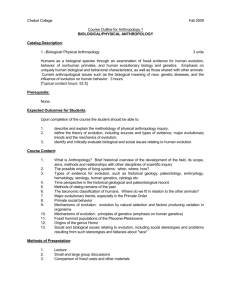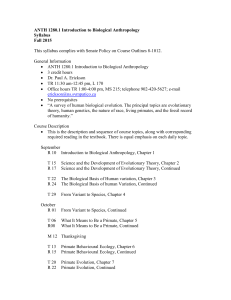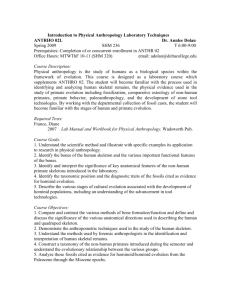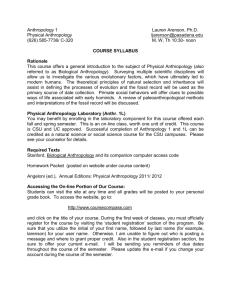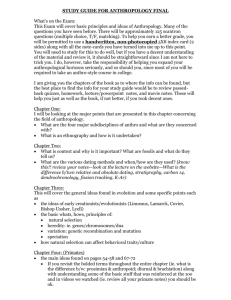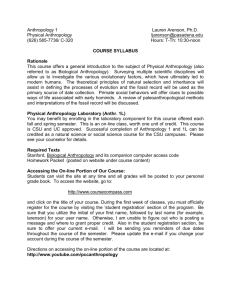ATH 2100 - Wright State University
advertisement
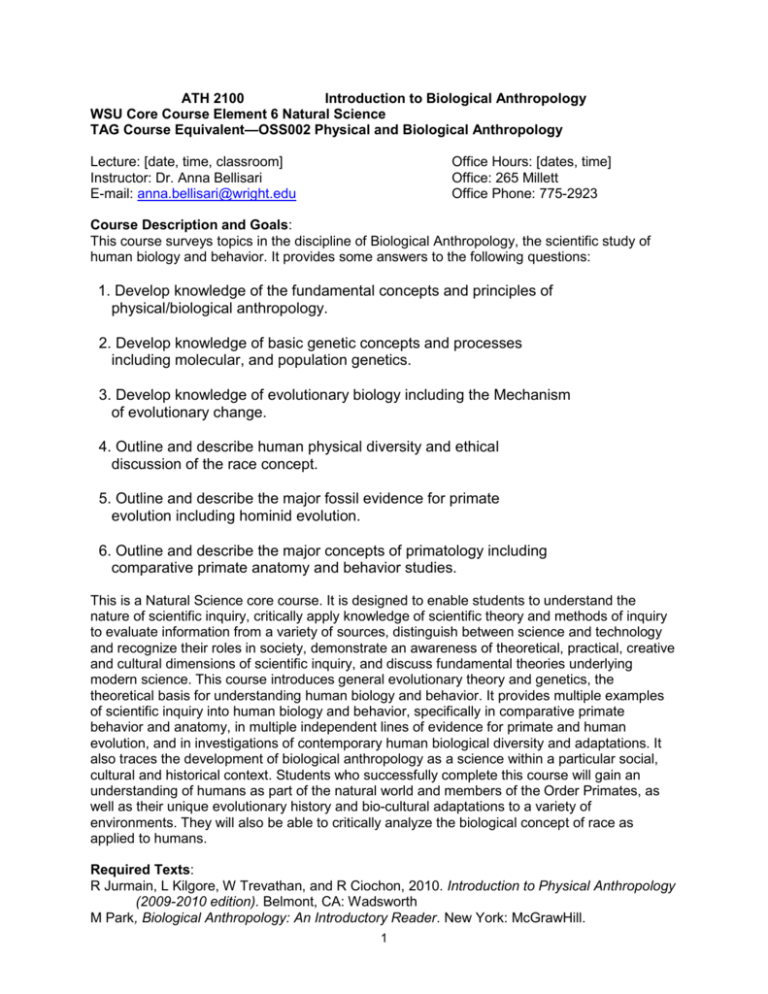
ATH 2100 Introduction to Biological Anthropology WSU Core Course Element 6 Natural Science TAG Course Equivalent—OSS002 Physical and Biological Anthropology Lecture: [date, time, classroom] Instructor: Dr. Anna Bellisari E-mail: anna.bellisari@wright.edu Office Hours: [dates, time] Office: 265 Millett Office Phone: 775-2923 Course Description and Goals: This course surveys topics in the discipline of Biological Anthropology, the scientific study of human biology and behavior. It provides some answers to the following questions: 1. Develop knowledge of the fundamental concepts and principles of physical/biological anthropology. 2. Develop knowledge of basic genetic concepts and processes including molecular, and population genetics. 3. Develop knowledge of evolutionary biology including the Mechanism of evolutionary change. 4. Outline and describe human physical diversity and ethical discussion of the race concept. 5. Outline and describe the major fossil evidence for primate evolution including hominid evolution. 6. Outline and describe the major concepts of primatology including comparative primate anatomy and behavior studies. This is a Natural Science core course. It is designed to enable students to understand the nature of scientific inquiry, critically apply knowledge of scientific theory and methods of inquiry to evaluate information from a variety of sources, distinguish between science and technology and recognize their roles in society, demonstrate an awareness of theoretical, practical, creative and cultural dimensions of scientific inquiry, and discuss fundamental theories underlying modern science. This course introduces general evolutionary theory and genetics, the theoretical basis for understanding human biology and behavior. It provides multiple examples of scientific inquiry into human biology and behavior, specifically in comparative primate behavior and anatomy, in multiple independent lines of evidence for primate and human evolution, and in investigations of contemporary human biological diversity and adaptations. It also traces the development of biological anthropology as a science within a particular social, cultural and historical context. Students who successfully complete this course will gain an understanding of humans as part of the natural world and members of the Order Primates, as well as their unique evolutionary history and bio-cultural adaptations to a variety of environments. They will also be able to critically analyze the biological concept of race as applied to humans. Required Texts: R Jurmain, L Kilgore, W Trevathan, and R Ciochon, 2010. Introduction to Physical Anthropology (2009-2010 edition). Belmont, CA: Wadsworth M Park, Biological Anthropology: An Introductory Reader. New York: McGrawHill. 1 Course Requirements: Exams (4) Lab exercises (10) 400 points 100 points Course Policies: No makeup exams will be given. Absence from an examination will result in a test score of 0 unless appropriate documentation for the absence from doctor, boss, commander, clergy, etc. is submitted as excuse from the exam. If documentation is appropriate, the course grade will be based on the two other exams and the lab exercises. The grading system of A = 90-100%, B = 80-89%, C = 70-79%, D = 60-69%, F = below 60% will be used for exams and for final grades. Grades will not be curved. An extra credit option is available. The Wright State University policy on academic honesty applies to this class. Mobile phones must be turned off during class periods. Entering the classroom late or leaving early is not acceptable. Food and drink should not be consumed during class. Course Outline: Week Topic Assignments 1 Anthropology & Evolution JKTC 1 Lab: Introduction Park 3, 4, 13 2 Evolutionary Principles Lab Exercise 1: Darwinian Medicine JKTC 2 Park 5, 7, 9 3 Evolutionary Genetics Lab Exercise 2: Genetic Equilibrium JKTC 3, 4 Park 10, 11, 12 4 Exam 1 Primate Behavior Lab Exercise 3: Primate Locomotion JKTC 6 Park 18, 19, 20 5 Primate Behavior (cont) Lab Exercise 4: Observing Social Behavior JKTC 7 Park 2, 38, 41 6 Primate Evolution Lab Exercise 5: Primate Classification JKTC 5, 9 Park 16, 17 7 Primate Comparative Anatomy Lab Exercise 6: Primate Skeletons & Teeth JKTC 8 Park 21, 35 8 Exam 2 Paleoanthropology & African Origins (Ardipithecus, Sahelanthropus) Lab Exercise 7: Miocene Hominoids JKTC 10 Park 1, 24 9 Hominin Evolution (Australopithecus, Paranthropus) Lab Exercise 8: Bipedal Locomotion JKTC 11 Park 36, 38 10 Early Human Evolution (Homo habilis, Homo erectus) Lab Exercise 9: Brains, Teeth, & Legs JKTC 12 Park 22, 23 2 11 Later Human Evolution (Homo neandertal, Homo sapiens) Lab Exercise 10: Cultural Evolution - Tools 12 Exam 3 Modern Human Variation Lab Exercise 11: Dermatoglyphics JKTC 15 Park 32, 33, 34 13 Modern Human Adaptations Lab Exercise 12: Osteology JKTC 16 Park 4, 27, 28 14 Biocultural Evolution & Interpretations Lab: Summary JKTC 17 Park 29, 37, 42 Finals Week JKTC 13, 14 Park 25, 26, 39 Comprehensive Final Exam - [date, time] Film Schedule: These films can be checked out of the WSU Media Library and viewed at your convenience if you have to miss a class period during which they are shown. Meiosis (30 min) – [date] DNA, RNA, and Protein Synthesis (30 min) – [date] Primates – [date] The New Chimpanzees – [date] Clever Monkeys – [date] Becoming Human (Part 1) – [date] Alien from Earth – [date] Race: The Power of an Illusion (Part1: The Differences Between Us) – [date] Biological Anthropology Discussions Select one of the assigned articles in the Biological Anthropology reader and add your name to the signup sheet in class. Prepare a brief summary of the main point/s of the article and its relevance to the course and present it to the class during the week it is assigned. Also present a question about the article for discussion by the class. Record your choice below as a reminder. Article Number First Choice ___________________________________________________________ Alternatives (just in case) _________________________________________________ Laboratory Exercises Laboratory exercises must be completed each week as scheduled and submitted by email or in hard copy format. Each student must submit 10 of the 12 exercises for a total of 100 points toward the final course grade. Additional exercises (maximum = 2) may be submitted for 5 points extra credit each. Sample films used in this course: The New Chimpanzees This film depicts a number of wild chimpanzees and bonobo field research programs descended from Jane Goodall’s pioneering study of the chimpanzees of Gombe. Clever Monkeys 3 A description of behaviors such as deception, cooperation, and tool use by monkeys, specifically to demonstrate their common ancestry with humans. Becoming Human (Part 1 – First Steps) Account of discoveries of the oldest hominins and a discussion of the mosaic pattern of human evolution (bipedialization, encephalizaton). Also demonstrates the uses of the molecular clock (based on genetic variation of contemporary species) and geological dating techniques to determine fossil ages. Alien from Earth About the discovery of Homo floresiensis and a critical analysis of its impact on current ideas about human evolution. A fine example of scientific controversies in paleanthropology, development of alternative hypotheses, and the variety of methods and techniques used in this science. Race: The Power of an Illusion (Part 1 – The Differences Between Us) Critical analysis of the biological evidence for human racial categories, reviewing early measures of “racial” variation, their application in eugenics and other discriminatory policies, and the modern genetic approach with emphasizes non-concordance of “racial” traits and the genetic unity of the human species. Includes work and comments of several African American biological anthropologists (Cobb, Graves). Description of Lab Exercises Lab Introduction Lab Exercise 1: Darwinian Medicine Exploration of evolutionary approach to human health Lab exercise 2: Genetic Equilibrium Calculation of population gene frequencies and equilibrium Lab exercise 3: Primate Location Comparison of primate modes of locomotion Lab exercise 4: Observing Social Behavior Comparing methods of behavioral sampling Lab exercise 6: Primate Classification Assessing evolutionary relationships in the Order Primates Lab exercise 7: Miocene Hominoids Searching for the Last Common Ancestor of humans and other hominoids Lab exercise 8: Bipedal Locomotion Skeletal and functional anatomy of unique human locomotion Lab exercise 9: Brains, Teeth and Legs Derived traits of the Genus Homo Lab exercise 10: Cultural Evolution – Tools Tool manufacture and use in human adaptation Lab exercise 11: Dermatoglyphics Individual and population variations in fingerprint patterns Lab exercise 12: Osteology Analyzing skeletal remains to identify sex, age, and measure cranial capacity Lab Summary 4 Sources: Kappelman, J. ed., Virtual Laboratories for Physical Anthropology (version 4.) Thomson/Wadsworth Jurmain, R., L. Kilgore, W. Trevathan, Basic Genetics for Anthropology (version 2.0) Wadsworth th France, D.L., 2007, Lab Manual and Workbook for Physical Anthropology (6 edition) Thomson/Wadsworth Williams, F.L., 2010, Exploring Biological Anthropology: An Integrated Lab Manual and Workbook Oxford University Press Sample readings from Biological Anthropology: An Introductory Reader: The Homegoing About forensic analysis of an indigenous Hawaiian buried in Connecticut to confirm identification and repatriate his remains to Hawaii; describes methods of forensic analysis. Piltdown, Paradigms, and the Paranormal. The discovery and ultimate rejection of the Piltdown “fossils.” Sex, Drugs, Disasters, and the Extinction of Dinosaurs Critical examination of three ideas regarding the extinction of dinosaurs, demonstrating that only one meets the criteria of a scientific hypothesis. Curse and Blessing of the Ghetto Natural selection explanation of the high frequency of the Tay-Sachs allele among Ashkenazi Jews. Close Encounters A “test” of ecological theory regarding inter-species competition between chimpanzees and gorillas in the Bwindi Impenetrable Forest of Uganda. Born to Run Description of a new analysis showing that endurance running may have been a selective factor in the evolution of human bipedalism. Differential Mortality and the Donner Party Disaster Account of human variation and natural selection among American pioneers marooned in the Donner Pass. Going Beyond X and Y The complexity of sex determination and the issue of human sexual ambiguity. Saartje Baartman: Her Life, Her Remains, and the Negotiations for Their Repatriation from France to South Africa The “Hottentot Venus” and scientific thinking about race in the past and during more recent times. 5

